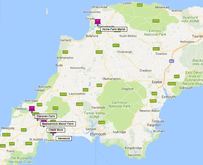What you can see from the permissive path
|
The excavation of ponds and scrapes has created new wetlands which attract many species of duck, including Shelduck, Wigeon, Shoveler, Pintail, Teal, Mallard, Garganey, Tufted Duck, Green & Grey plovers, both species of Godwits, Snipe, Little Egrets and Grey Herons, with signs that some are now breeding for the first time for many years.
Wetlands have been restored by blocking some field drains, creating habitat attractive to Canada Geese, Common Redshank, Greenshank, Teal and a range of waterfowl and waders, plus breeding Moorhens. Volunteer wardens have reported sightings of Water Voles and Water Shrews in the past. Otters are thought to feed in the estuary and to use the ponds on the Marsh to wash the salt out of their fur. 3 large arable fields on higher ground are managed with farmland birds in mind, with spring-sown crops and the stubble kept over winter to provide food and cover for a range of birds, mammals and invertebrates. This management regime is encouraging the spread of wild flowers typical of arable fields. Four blocks of seed-bearing plants have been planted, such as cereals, quinoa, kale, millet and sunflower to provide cover and food for birds. Tamarisk (Tamarix ramosissima) hedges have been coppiced back to encourage new growth to provide more effective shelter, and nearly 900 meters of new hedge bank have been created, planted with native shrubs, enabling visitors to walk across the Marsh unseen by birds feeding or roosting on it. Two pastures near the estuary, 4633 & 6932 have produced some interesting botanic records with Blue Fleabane (Erigeron acer), Bugloss (Anchusa arvensis) and Dwarf Spurge (Euphorbia exigua). Grasses that thrive in wet pasture, like Tufted Hair-grass and Reed Canary-grass are now spreading within the marsh. |



